
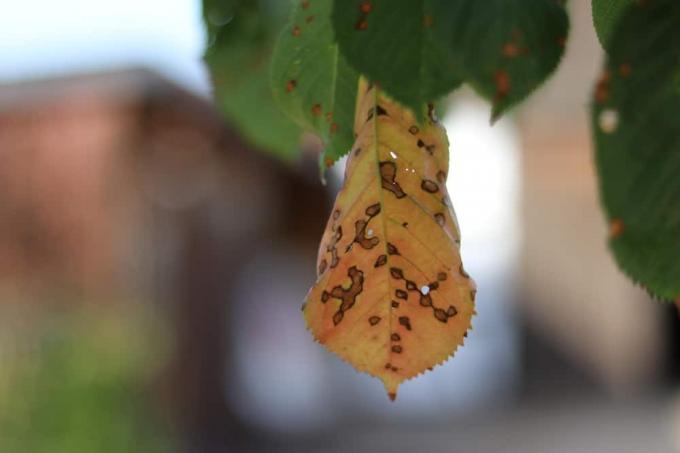
Table of contents
- fire blight
- Attention: reporting obligation
- sharka
- apple scab
- Prevention is better than cure
- apple powdery mildew
- pear grating
- sooty mold
- shotgun disease
- frizz disease
- leaf tan
- Conclusion
Fruit trees can be attacked by various diseases. Luckily, there are not that many pure leaf diseases, but numerous diseases can be easily identified on the leaves. The most dangerous fruit tree diseases are fire blight and sharka, followed by fruit tree canker.
fire blight
Many leaf diseases are caused by fungi, while the fire blight pathogen is a bacterium (Erwinia amylovora). It is not a pure leaf disease, but is best recognized on the leaves. Affected fruit trees are mainly pome fruit types, i.e. apple, pear, quince and others. There are several ways of infection and spread, such as migratory birds, the weather, contaminated plant material, insects, animals and also by humans. The most common type of infection is the flower infection, followed by the shoot infection and older infested sites that have become active again. Fire blight can be recognized by the fact that the leaves of some shoots have turned black-brown and dried up. The bacterium clogs the pathways.

The leaves can no longer be supplied with water, they die.
- bacterium
- Not a pure leaf disease, but recognizable on the leaves
- Infection possible from spring to autumn
- Ideal growth temperatures between 21 and 28°C
- The flowers are particularly at risk
- Portals of entry Flower stalk, respiratory openings, wounds
- Distribution dependent on tree health and age
- Bacteria survive in the diseased bark (sunken bark plates)
Attention: reporting obligation
The fire blight is notifiable. It's a quarantine disease. Suspicious symptoms should be reported to the Plant Protection Office. If it is proven to be fire blight, control measures are prescribed. Not only pome fruit trees are affected, but also other popular trees and shrubs, such as mountain ash, service pear, crabapple, medlar, medlar, hawthorn, firethorn, hawthorn and others. Fire blight can only be fought on older trees. Young fruit trees should be cleared. If the infestation is severe, clearing is also the best option. When choosing a variety, it is important to choose a robust fruit variety. However, there are no resistances.
- Prune diseased shoots back into healthy wood
- Report infestation (Plant Protection Office)
- Accrued wood must not be composted
- Burning is best
- Disinfect cutting tools (with 70% alcohol)
- Plant robust fruit varieties
sharka
Sharka disease is caused by a virus and affects stone fruit, mainly plums, damsons, peaches, nectarines and apricots. This disease is also notifiable. Due to different virus strains, the symptoms on the plants can also differ, or they are differently pronounced. Light olive green rings can be seen which may develop into black dots (dead tissue) on the leaves. These form mainly in the spring, around May/June. The fruits, on the other hand, have depressions that are pock-like or line-shaped. Underneath, the flesh takes on a reddish color and a rubbery consistency. The fruits often fall off prematurely.
- viral disease
- Affects stone fruit
- Prefers some types of fruit
- Identified by light olive rings on the leaves, mainly in spring
- Later black spots (dead tissue)
- fruits also affected
- Particularly intense occurrence in warm and dry conditions during the growing season
- Transmitted by aphids or by grafting on infected shoots or rootstock
You cannot fight the virus directly. However, the spread should be avoided or at least reduced. This can be done with a few targeted measures. Prevention is also not possible.
- Control aphids
- Uproot and remove infected plants
- Use virus-free scions and rootstocks
- Plant less virus-susceptible or resistant varieties and rootstocks
apple scab

Apple scab is one of the most important apple tree diseases worldwide. The cause is the sac fungus, Venturia inaequalis. Typical are dull olive-green spots on the leaves, which later take on a brownish to blackish color and can merge. They form necrosis, which in turn leads to premature leaf drop. The disease can also be seen on the fruit. They usually have darker colored spots. Star-shaped cracks can appear in these. Through the cracks, other pathogens can get into the pre-damaged apple. This affects the shelf life, but has no effect on the edibility.
- fungal disease
- Affects leaves and fruit
- In addition to apples, pears, cherries, peaches and other types of fruit are also affected by rust
- High reproduction rate
- Infection depends on the weather, wetness and temperatures between 16 and 22°C are ideal
Prevention is better than cure
The selection of robust fruit tree varieties is important, as well as the right location and good care. Resistant varieties are now commercially available and should be preferred. Furthermore, the following things must be observed:
- Discard infested foliage and fruit. Don't leave it lying around and don't put it in the compost
- Thin out trees regularly so that the leaves can dry well (wind)
- Balanced fertilization
- Preventive spraying with appropriate agents (always only before precipitation)
- First spraying before spore flight in March
Control includes spraying at the beginning of or just before spore flight at the end of March. A combination of preventive base and contact spraying is beneficial. The same means are not permitted for home gardens as for commercial cultivation. In addition, some are constantly being removed from the range or added. new ones are added. Here you should get the appropriate information from a specialist.
- injections for prevention
- Surface spraying - all infected tree parts are protected by a closed surface
- It is important to comply with the concentration and the application recommendation.
- Usually at least 5 injections are necessary, at intervals of 7 to 14 days
apple powdery mildew
Apple powdery mildew is a powdery mildew caused by the fungus Podospharea leucotricha. Leaves, but also other parts of the plant are covered with a whitish mealy layer, which also explains the name apple powdery mildew. The pathogen lives on the surface of infected plants, but penetrates them to extract water and nutrients. Infections are only possible on young tissue.
- fungal infection
- Only affects apple trees, fungus has specialized
- Whitish mealy coating on affected parts
- Only young tissue becomes infected.
In addition to leaves, flowers, shoots and fruits can also be infected
- Affected flowers do not produce fruit
- Usually occurs between mid-May and mid-June.
- Prefers rather dry weather and temperatures between 20 and 25°C
- Affected leaves dry up and fall off. Annual shoots bare from below. Apples show a net-like russeting.
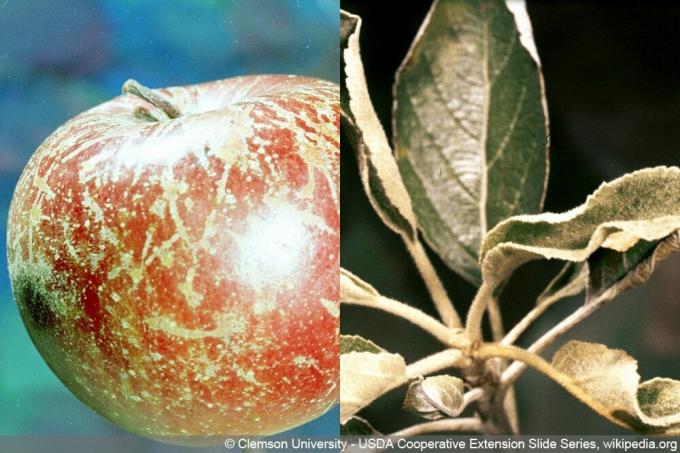
Clemson University - USDA Cooperative Extension Slide Series, Bugwood.org -, Podosphaera leucotricha (Ellis & Everh.) E. S Salmon -UGA1236181, edited by Hausgarten, CC BY 3.0.
Here, too, all sorts of things can be achieved through prevention. Infected shoots should be removed in good time, right at the winter pruning. A light crown is also important here, which is why it should be thinned out regularly. In addition, the susceptibility depends on the variety. Some varieties are highly susceptible, such as Jonagold, Elstar and Cox Orange. As a rule, apple varieties with hairy leaves are more susceptible than those with bare leaves.
- Thin out regularly
- Remove affected shoots
- Choose apple varieties with smooth leaves
- No varieties with hairy leaves
The infestation can be prevented or minimized by a combination of different measures. be contained. This includes cutting and spraying.
- Winter pruning – remove infected shoots
- Regular outbreaks of infected shoot tips in early summer
- Sulfur sprays on susceptible varieties
- After flowering start until August
pear grating
Pear rust is a fungal disease, more precisely a rust fungus. This fungus actually infects a wide variety of juniper species. There it causes knotty thickening of the branches. In the spring, the spores are dispersed by the wind and end up on the leaves of the pear trees. This infection thus begins on the upper side of the leaf. Initially, orange-red spots can be seen on the leaves. These are constantly increasing. If the weather is right, the fungus can multiply explosively. Insects help. They are attracted by secreted nectar. In summer, the fungus grows through the leaf. Irregular, brownish growths, spore deposits, now appear on the underside of the leaf. When the spores are ripe, the surface bursts, the winter spores fly out and can infect the juniper again.
- Young trees can be seriously damaged
Growth and harvest are severely impaired
- Settles on juniper
- Two junipers in particular are affected: Sade tree (Juniperus sabina), Chinese juniper (Juniperus chinensis)
- fungal disease
- Spores infect pear trees
- Orange-red spots on leaf surface
- Later irregular, brownish growths (spore beds) on the underside
- When the spores are ripe, the spores fly off
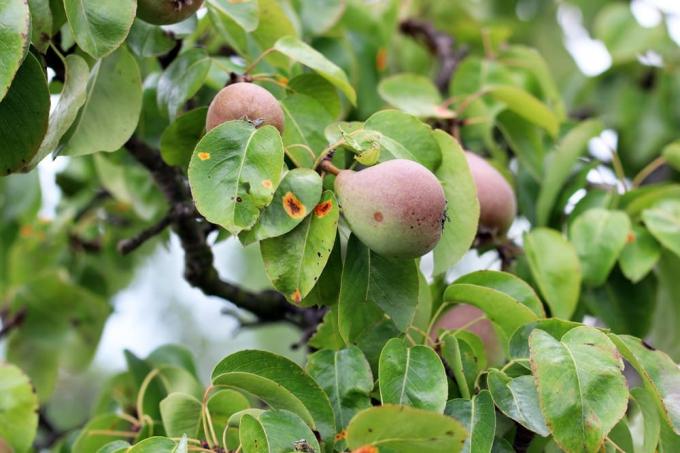
The only way to prevent infestation is to remove all junipers from the garden. However, if the neighbors also have some, you have to convince them too. It is then safer to use plant strengtheners such as horsetail extract. The trees should be sprayed every 14 days, starting with the budding, at least 4x.
- Remove juniper
- Plant resistant species e.g. B. Juniperus communis, common juniper.
The control must start with the pear tree and the juniper, otherwise the cycle will never end. The winter spore deposits on the juniper must be combated. The best way is to remove the affected trees and shrubs. The flight radius of the spores is about 500 meters, even more in strong winds. At this distance, the trees should be removed. Usually this limit goes beyond your own garden and the distance becomes difficult. The owners often do not see this. But sometimes it is enough to remove the affected areas on the trees. Alternatively, resistant species can be planted.
- Combating juniper: Cut out affected areas or, better yet, remove the entire plant. Alternatively, plant a resistant variety
- Control of the pear tree: spray fungicides, preferably when the spores are in flight (Duaxo Universal fungus-free from Compo) The agent is also effective against other fungi, e.g. B. leaf curl, rust, scab, powdery mildew and many types of leaf spot diseases. Use plant strengthening agents, spray triazole prophylactically, at intervals of 14 days
sooty mold
Sooty mold is a black fungal infestation. It mainly occurs in late summer. The sooty fungi prefer to colonize leaves on which honeydew sticks. These, in turn, are the excrements of aphids, scale insects, whiteflies and cicadas. Affected are apple trees, pear trees, apricots, cherry trees, peach trees, plums and plums. The infestation can be recognized by black covered spots of different sizes on the upper side of the leaf. The leaves can also be colored completely black. They can no longer absorb solar energy and die. In the case of fruit trees, the damage is usually not very severe. Ants harvest the sticky secretions.
- Fungal disease – sooty fungus
- Settles on excrements of harmful insects
- Many fruit trees affected
- Usually no major damage
Not much can be prevented. Strengthening the trees is a good option. Plant strengtheners help with this. In addition, the trees must be checked regularly for pests in order to be able to combat them as early as possible. If there is no honeydew, there is also no sooty mold infestation.
- plant strengthener
- Control pest infestation
The control is mainly aimed at the pests. Aphids in particular must be combated. In addition, ants should be kept away from the trees. They encourage honeydew secretion because they want to harvest. They keep the aphids like pets.
- Fight pests, especially aphids
- keep ants away
shotgun disease
Apricots, cherry trees, peach trees, plums and damsons can be affected by shotgun disease. The cause is a fungus, more precisely Wilsonomyces carpophilus. The disease can be seen on the new leaves. Red-brown, round spots form there, which later become holes. If the infestation is severe, the foliage looks like it has been shot up by shot, which is where the name of the disease comes from. The affected leaves dry up and fall off prematurely, usually as early as June or July. The lower parts of the tree are often more affected than the upper ones. The trees can be completely bare early on. The fungus can also attack branches. Young shoots show cracks. Fruits are also affected. They show spots with red borders and funnel-shaped indentations. At times they are also completely crippled. Whole branches can die off. The trees are particularly at risk from May and then until the end of the growing season.
- fungal disease
- Occurs mainly in damp, cool, rainy weather
- Multiplies explosively in favorable conditions
- Areas with heavy fog formation are particularly at risk
- Spread by raindrops
- Fungus penetrates the epidermis and tissues
- Can also penetrate through the attachment points of fallen leaves
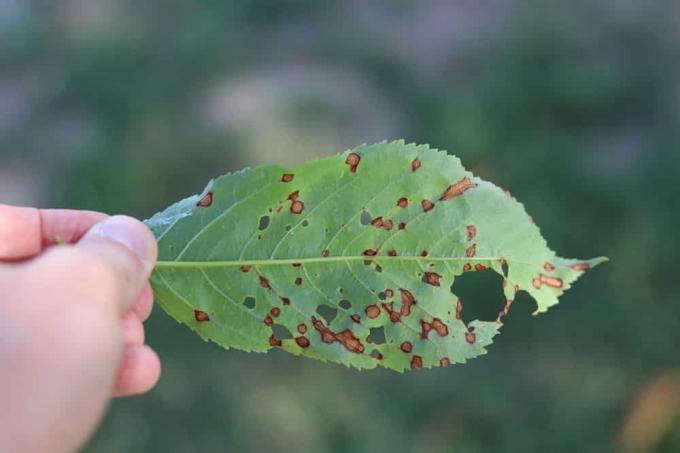
Infested foliage must be removed to combat shotgun disease. This also applies to infested fruits. Severely infested trees should be cut back down to the healthy wood (wood can also be infected). This lowers the risk of infestation and the leaves on sparse trees dry off more quickly. Peach trees should be sprayed with copper preparations just before the leaves fall. This prevents late infections. Alternatively, synthetic fungicides can be sprayed in the summer.
- Remove leaves and infested fruit
- Cut back heavily
- Spray on peaches to prevent late infection.
- Fertilize sparingly, especially nitrogen
- Organic farmers use clay preparations and wetted sulphur
frizz disease
Curling disease is also known as blister disease. It is triggered by a fungus and primarily affects peach, nectarine, apricot and almond trees. The disease can be recognized by the leaves, which curl significantly and show light green and/or red blisters when they shoot in spring. The diseased leaves turn whitish-green and appear rubbery and brittle in the final stage. The tree sheds its leaves but produces a healthy new shoot. The good thing is that the fungus is not infectious above 16°C. However, the tree is weakened overall and if the disease occurs for several years in a row, entire branches can die off and the tree has to be uprooted in the end.
- The causative agent is a sac fungus
- From the end of February/beginning of March, the rain washes shoot cells into the newly opened buds of the tree. There, the leaves that have not yet unfolded become infected and flower buds become overgrown. From this point on, there are no more antidotes.
- In May, the fungus forms spore stores. Recognizable as a delicate, plush fuzz.
- Infestation occurs particularly in wet winters

The best way to prevent this is to plant disease-resistant varieties, if they exist. It also helps enormously to plant the trees against a house wall or even better under an eaves to protect them from rain during the critical winter months. This is the only way to prevent infection. If necessary, a tarpaulin can also be hung over it, at least until the temperatures rise above 16°C.
- Plant disease-resistant varieties
- Plant trees close to the house or under an eaves
- Cover with a tarpaulin if necessary
- Glue rings on the trunk
- Adequate watering
- Sufficient nitrogen fertilization
- plant strengthener
Combat is difficult. In commercial cultivation there are sprays, but these are not permitted for the home garden. Since new funds are approved every year, it is worth asking the specialist trade about them.
- Spray with fungicides, usually those containing copper or peracetic acid, just before bud break in January or February
- Start at temperatures above 10°C
leaf tan
Leaf blight is a fungal disease that affects leaves and young shoots. Mainly sweet cherry trees and quinces are affected, but also apricots and sometimes apples and pears. The leaves of the cherry trees turn brown as early as the end of May, but do not fall. By the end of August, the entire crown will turn brown. The leaves remain hanging even in winter, but they remain curled up. The twisted petioles are also clearly visible. In quince, chlorotic, light yellow discoloration of the leaves can be seen. Leaves may fall off. The fruits are also affected and are not suitable for consumption.
- For cherries - leaves turn brown, curl up and hang, even throughout the winter
- In quinces - light yellow discoloration of the leaves, often due to lime deposits in the soil
Plant strengtheners such as horsetail broth are used for prevention. Spraying should be repeated as soon as the shoots start to sprout. If infested in the months of May to June, the copper agent should be sprayed twice, although this is not approved for home gardens.
- Plant strengtheners such as horsetail broth
- Inject copper agent
- Give fruit trees plenty of space, they should be freestanding
- Distance to buildings or other trees 6 to 12 m
- Thin out the crown annually
To combat leaf blight, all leaves should be collected and destroyed. They don't belong in the compost. If copper agents are allowed, then spray before budding. Always keep the crown nice and light and trim regularly.
Conclusion
There are a lot of leaf diseases in fruit trees. Not all are pure leaf diseases, fruits, flowers and shoots can also be affected. With some diseases, however, the leaves indicate the infestation and are easy to identify. There are serious diseases that can end in the death of the tree and there are also rather harmless ones. In any case, prevention is better than cure. It is important to choose robust fruit varieties. Location and care must also be right. Nevertheless, diseases cannot always be reliably avoided. Early detection and the rapid initiation of countermeasures then help. Plant strengtheners help the trees and cannot cause any damage.
 garden editorial
garden editorial I write about everything that interests me in my garden.
Learn more about plant diseases

White spots on leaves: what to do?
Whether in the home or in the garden, white spots on the leaves of your favorite plants are always a cause for concern. However, the causes can often be eliminated quickly. This guide summarizes the most common triggers and gives tips for quick help.
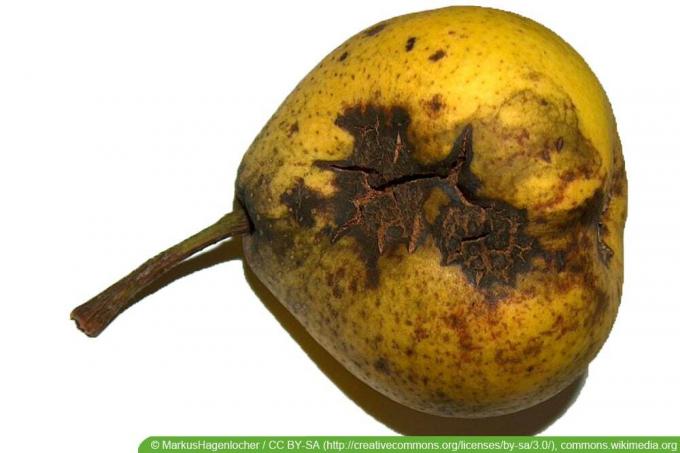
Recognizing pear scab & biological control
Pear scab (Venturia pyrina) is a disease of pears caused by a fungus. It leads to spots on the young fruits, which are then shed or stunted. Read here how to fight or avoid the disease.

Walnut Tree: Fight 7 Common Diseases and Pests
The Juglans regia, as the real walnut tree is called in botany, rarely gets sick and it defends itself immensely against damage by pests. But some diseases and pests require quick action. The plant expert explains and describes possible control methods.

Wilted leaves on cucumbers: cause cucumber wilt - what to do?
Wilted leaves on cucumbers are not uncommon, because the plants are sensitive and susceptible to diseases. However, if the cause is cucumber wilt, appropriate measures must be taken and other plants protected as well. We tell you what to do here.

Plant diseases on indoor plants - recognize and combat
Numerous plant diseases are caused by microscopic organisms, including bacteria, fungi and viruses. These penetrate plant cells and damage the entire plant, often fatally. In addition, animal pests can also extremely weaken indoor plants. Early detection and immediate remedial measures are important in order to save infested plants.

Ground cover roses: care from A – Z
All varieties of ground cover roses are attractive plants with an abundance of flowers consisting of single or double, single or multicolored and delicately scented flowers. Sometimes they even bloom several times a year. They are a low-maintenance and pretty alternative to green ground covers.
